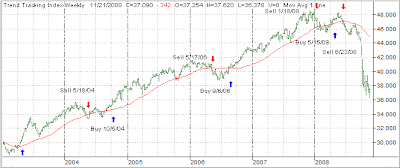 Ever since the markets made new lows in October many investors, as well as the folks on Wall Street in general, were on a quest to declare a bottom which, I guess, was supposed to be followed by an imminent and profitable turnaround.
Ever since the markets made new lows in October many investors, as well as the folks on Wall Street in general, were on a quest to declare a bottom which, I guess, was supposed to be followed by an imminent and profitable turnaround.
I received my share of emails from readers curious about the subject of bottom fishing. The WSJ had this to say a few days ago on that topic:
Investors in equities remain on a quest for clarity, the knowledge that stocks have indeed reached that fabled bottoming-out point that suggests a return to more bullish days — or least, something less volatile and bearish.
Mary Ann Bartels, technical research analyst at Merrill Lynch, notes in commentary Monday that the market has seen its classic selling climax — evidenced by 90% up days reached in October that “signaled the beginning of a base-building process.” She warns again, however, that the period of “testing” the lows can be long and arduous, and involve indexes falling to new lows.
Referring to Thursday’s action, which saw the Dow swing in a 900-point range in one day, she argues that this was likely the third test of the lows reached October 10. Still, she says that the market still has “its work cut out for it,” pointing to resistance levels of 960 to 1000 on the Standard & Poor’s 500-stock index and 9300 to 9405 for the Dow.
Ryan Detrick, analyst at Schaeffer’s Investment Research, is looking for a worsening of the current trend, pointing to the 21-day moving average of the International Securities Exchange’s put-to-call ratio. The current average is 1.35, far from the 2002 market low of 0.95.
“I think there is still too much optimism for an ultimate bottom to have formed,” he writes. “For the time being, the short-term trend could be poised to turn higher, but the long-term trend persists lower. I still think commodities will lead the market lower, as hedge funds continue to unwind their positions.”
Attempting to pick a bottom is nothing but a crap shoot. You might as well go to Las Vegas and try your luck at the tables.
“What comes down goes down further,” has been the theme of the past few months and those ignoring the fact that we are just in the beginning stages of a (potentially lengthy) bear market, most likely learned another costly lesson.
While buying on dips is a favorite hobby for many, it ignores two facts:
1. It works only sometimes in well defined bull markets.
2. It’s a killer in bear markets, unless you keep believing your clueless broker when he utters the famous and very costly words that “the market can’t go any lower,” and “prices are a great value.” Yeah right.
This alleged market bottom is made of quicksand. Stay away until a clear turnaround is evident. Those who have moved back in are probably having the same thoughts as the trader who was overheard saying on the floor that “I don’t want the cheese anymore… I just want out of the trap.”






